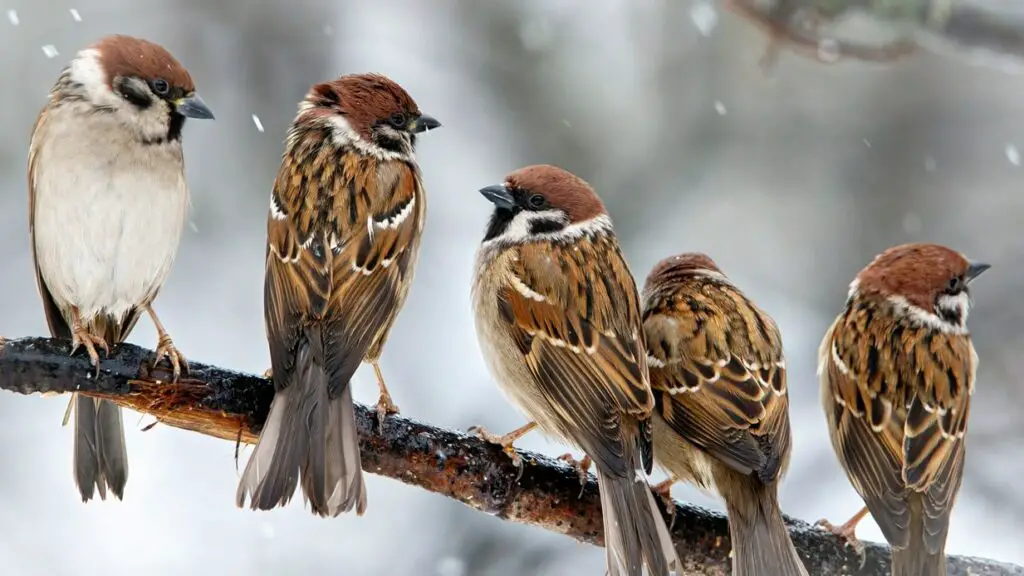Sparrow is the common name that describes the 43 bird species within the Old World Sparrow family, Passeridae. These birds are in a different family than the New World Sparrows, Passerellidae, which are more similar to finches and buntings than sparrows.
In general, sparrows are a short-lived species, averaging only around three years of age before they die. However, they are a prolific species, enabling them to colonize areas quickly, often pushing out native, more desirable Passerine bird species.
These tiny birds are typically drab in color, brown and gray, with short tails and compact beaks that they use to eat seeds. They have specialized adaptations in the structures of their beaks and tongues that allow them to eat many seed types.
Old World Sparrows are native to the continents of the Old World in Europe, Asia, and Africa. People introduced several species into North America, South America, and Australia, where they became naturalized as they readily adapted to heavily developed urban areas.

How Long Do Captive Sparrows Live?
In the United States, the Migratory Bird Treaty Act, a federal law that protects most wild birds, prohibits people from keeping these birds as pets. The exceptions to this law allow non-native bird species in the US, such as House Sparrows, to be taken from the wild.
Sparrows are short-lived birds, even when kept in captivity. Some sparrow species may live up to five years when kept safe from predation and disease, but most do not live more than three years.
People occasionally keep House Sparrows as pets, especially if they find them as nestlings or injured birds. While raising birds can be fun, researchers recommend taking abandoned and injured wild animals to a certified wildlife rehabilitation center.
How Long Do Wild Sparrows Live?
The scientists who study sparrows and other Passerine birds typically capture them, collect basic information about their length and weight, then band one of their legs to give them a unique identifier before releasing them back into the wild.
When someone recaptures a banded bird, researchers learn more about that individual’s life history. With enough recaptured individuals, they can learn more about the species as a whole. In wild sparrows, scientists have collected many individuals worldwide and banded them.
While bird banding information does not give scientists a complete picture, they can begin to understand sparrow longevity. Wild sparrows usually only live around three years, depending on their environment, but they can live for 20 years in some cases.
What Kills Sparrows?
Wild sparrows are constantly at risk of dying from predation, disease, and human interaction. Sparrows flock together in groups to find food more efficiently and to deter predators, but this flocking behavior can make them vulnerable to other risks.
Predators that prey on adult sparrows from the air include several owl species, hawks, falcons, shrikes, and merlins. When flocking, sparrows can confuse potential avian predators when they take off in a flurry of wings.
Nestling sparrows and eggs are easy prey for snakes, cats, dogs, raccoons, rats, and other small predatory mammals. If predators find a sparrow nest, they often eat everything in the nest, causing nest failure.
One research study has found that sparrows living in urban environments can become too accustomed to humans. This habituation can cause sparrows to be easier prey because their flight response is not triggered until the predator is too close.
Sparrows can become a nuisance to humans, and people sometimes use poison to deter or reduce their sparrow population. Unfortunately, poison often kills additional animals accidentally. Despite the incidental deaths, some people still choose poison as a deterrent.
Diseases are common killers of sparrows in the wild. Because sparrows flock together, contagious diseases can quickly kill many individuals within a flock. These diseases include Avian Malaria, protozoan parasite infections such as Plasmodium relictum, and Avian Influenza.
What is the Oldest Sparrow?
While the average sparrow does not live more than a few years, some sparrows live for several years to two decades. Longevity records for sparrow species are scarce, however, and sources sometimes report vastly different maximum longevity for the same species.
Many longevity records for sparrows come from anecdotal evidence because little research exists. Some sparrow species do not have any anecdotal information or research data identifying their maximum longevity.
The maximum age for sparrows ranges from 6 to 23 years, depending on species and available data. According to the Cornell Lab, the oldest wild House Sparrow in the US lived for over 15 years, while the Animal Aging and Longevity Database lists its maximum age as 23.

We rescued a baby house sparrow at our local Lowe’s in 2017. She was dangling from a net above the garden center, a worker used a forklift to get her. Lowe’s had the net removed shortly after. Many baby birds died trapped in that net. Belita is 6 years old now. She’s so smart. I hate to read that people poison these amazing little birds.
Thank you for this article it’s sad to hear that the only live three or four years. I’ve been feeding the kids for many many years. And I do pray for the crow kids and Sparrow kids and all the kids everyday thank you for
As for me, I change the water in their birdbath often during the day, since other birds (robins and crows) visit, too. We live in a beautiful world. Gazing at birds and stars and gardening are my favorite pastimes.
I think of sparrows as penny toys God gives to us to delight in in childlike pleasure. A day is truly empty without the sight of one. The mere sight of a Sparrow on a porch railing makes the World less lonely and big.